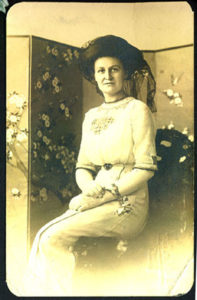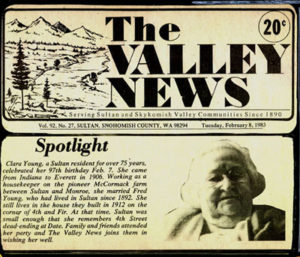Her Granddaughter Remembers …1886 – 1983
By Roberta Jonnet
 Clara Morris Young lived what some may say was a common life. But what brought my grandmother west to Washington State and Snohomish County must have been an uncommon sense of adventure. She came to work, socialize and dance, and stayed to marry and raise a family. She adored being called “Mom” and “Grandma” and cooking and keeping house for a husband and two sons.
Clara Morris Young lived what some may say was a common life. But what brought my grandmother west to Washington State and Snohomish County must have been an uncommon sense of adventure. She came to work, socialize and dance, and stayed to marry and raise a family. She adored being called “Mom” and “Grandma” and cooking and keeping house for a husband and two sons.
Clara Edith Morris was born February 7, 1886 outside the town of Mitchell, Indiana. She was the second of five children born to Robert J. Morris and Sarah Belle Terrell. Her older sister, Margaret, had married Frederick McCormick, and they were living in Snohomish County when Clara decided to join them
Arriving in Everett in 1907, Clara Morris was part of an influx of mid-Westerners to Snohomish County. The Polk City directory of 1907 states “Fifteen years ago the site…on which today stands this thriving manufacturing and commercial center, was an almost impenetrable virgin forest.” The directory reveals that the city was equipped with “electric street railways, first-class waterworks…two telephone systems, gas works, electric lights…two well equipped hospitals, a theatre that would be a credit to any eastern city…thirty-three miles of graded and improved streets…Nineteen buildings make up the public school property…the total number of school children is 4,700.”
Clara arrived at a time when the city was expanding rapidly. Lawrence O’Donnell writes in his book, Everett: Past & Present, that the city population grew from 8,000 in 1900 to 24,814 in 1910. New arrivals came from all over the United States and from overseas. The 1907 Polk directory lists Clara Morris as a “domestic” at 2614 Wetmore Avenue. She would have been twenty-one years old. In 1909 she was living in a boarding house at 2132 Oakes, which meant she had to walk a mile to work as an “ironer” for Independent Laundry at 28th and Cedar because streetcars did not serve that area. In 1910 she got a job as a maid at the Merchant Hotel at 1501 ½ Hewitt Avenue.
Her days were spent earning a living as a single, self-supporting woman, but her life was not all work and no play, as her family discovered when Clara’s keepsakes were found some 75 years later. Among her personal papers are invitations to numerous dances held in Everett from 1909-1911. Some invitations are addressed to her residence, some to her place of employment. One invitation reads “Gentleman One Dollar” and “Ladies’ Complimentary.” It was for the Opening Dancing Party for Rennie’s Dancing Academy, featuring Stormfels’ Orchestra at the Masonic Hall for Wednesday Evening, September 8, 1909. G.W. Stormfels was a violin- maker who owned a music store and boasted a five -piece band. “Dancing,” the invitation continues, “begins promptly at 9 p.m.” Clara had a late night.
In 1910 Clara was invited to attend a “Special Pre-Lenten Dancing party”. Ladies complimentary and “ten minutes devoted to the introduction and instruction on the latest dance ‘The Royal.’ Another invitation to a dancing party at the Eagles Hall in Snohomish advises a “special car leaves Wall and Colby at 8 p.m.” for the Saturday night dance. A note at the bottom directs, “Come prepared to make fun and enjoy fun.” Who could resist?
Clara’s life changed forever when she met and married Frederick R. Young of Sultan. Frederick was the son of Daniel and Sophia Kropf Young, who brought their family to Sultan in 1892, a year before the railroad reached the town. Clara’s sister and her husband introduced the couple. Clara and Frederick were married in the McCormick’s living room July 10, 1912. Fred said he was particularly struck by Clara’s “stylish” manner of dress when he met her.
There is a studio photograph of Clara seated on a stool, wearing a gauzy, shirtwaist blouse with embroidery on the bodice; a slim, straight skirt and a hat. Lifestyle records report 1908 was the year slim dresses without petticoats became popular. Also, no fashionable woman left her house without a hat in the first decade of the 1900s. Clara was evidently a fashion slave.
Frederick and Clara lived at corner of 4th and Fir in Sultan and raised their family. A daughter, Irma, born in 1916, died at the age of four months. Maurice was born in 1919 and Forrest in 1921. Clara always claimed that her sons were well mannered and easy to raise. A cousin of the two boys, however, told another story. He witnessed Clara standing by the front gate, tears running down her face, telling the boys she was leaving home because they “would not mind.”
Clara had the company of her sister-in-law, Sophia Young Jenft, as well as her husband’s sisters-in-law, Hilda Wolters Young, married to William Young; and Olive Humphries Young, married to Daniel Young, Jr., in raising their families in Sultan. Olive Young and Sophia Jenft were widowed early in life and left to raise their sons alone. The four women and their families visited each other’s homes, held dinners, celebrated birthdays and holidays, and mourned their losses together.
One of Clara’s activities later in life was participation in the Congregational Ladies Aid Society in Sultan. Family members recall that the group met for many years after the church had ceased holding services and closed it doors. The women gathered in one another’s homes to socialize and to complete a quilt for each member of the society in turn.
Clara’s activities were curtailed when she fell at the age of 60, breaking a hip. Arthritis set in, making walking difficult and keeping her on crutches until her death at age 97. Being a “shut-in,” so to speak, did not hamper her social life, for Clara had her phone and kept the party line busy. It was typical to come into her home and find her chatting away to a neighbor, friend or family member at all hours of the day and night. The Sultan “Home Chats” may have been a regular column for The Valley News, but the ladies of the town kept the real news alive via telephone.
Clara’s many gifts included cooking. She made a chicken that just smelling it frying in the pan made one’s mouth water. Her potato salad, made with plenty of mayonnaise, onion and sliced eggs, was a family favorite, and was often a special request for birthday dinners. Clara, who made and rolled out her own pie dough until she was 95 years old, would sit on a metal stool with a padded seat covered in blue plastic. Her sons had built and put in her kitchen cabinets, making the countertops lower so she could sit to work. I recall helping her cook by collecting the ingredients for her. The kitchen cabinets, which held the spices, flour and sugar, went up to the ceiling by the back door and gave off a rich aroma when the doors were opened. Clara always wore a bib apron in the kitchen, and a spare apron hung in the corner behind the stove.
Fred and Clara always attended the annual Pioneer’s Picnic, later called the Old School Mates’ picnic. These were annual gatherings in Sultan in August for anyone who had lived in town or attended school there. People from across the country would return to Sultan, bringing their hampers and picnic baskets of food to share at the high school. Tables were set up on the lawn, and the day was spent visiting and eating. Clara packed a mean hamper of food: cold meat sandwiches, potato salad, and apple pie.
My grandmother had a way of making life enjoyable for everyone, no matter what their ages. My cousin, Pam, and I would play “dress up” at Grandma’s house. We reveled in the hats, coats and dresses we found in her closet. We would put on an outfit, complete with hat of course, and then parade into the living room to show her, much to her delight. Some years later, when I was shopping for a wedding hat, I went to Chaffee’s on Colby in Everett. Grandma always asked to be taken to Chaffee’s when she wanted a new hat.
I remember that Clara did not have stomachaches or headaches, and took few if any, medications during her life. She ate sliced onion sandwiches with mayonnaise and used lard in her frying pan. She would ask about the health of her daughter-law’s father, who was ten years younger than Clara, referring to him as “the old man.” She shunned anything associated with being an “old lady.” She did not care for the shawl her son brought her from the Holy Land, and she would not be caught dead in lavender or purple because as far as she was concerned, these were “old ladies’” colors.
 Clara lost Fred in 1963. He died the day after President Kennedy was assassinated. She outlived her siblings and nearly all her friends and neighbors, a fact that troubled her in her last years. Clara missed her contemporaries, the people with whom she shared her life and times. However, her independent spirit, which brought her west as a young woman, served her to her last days. She lived alone from 1963 until a home care worker moved in to assist her a year before Clara’s death. Her sons honored her wish to live in her home and kept in close contact with phone calls and daily visits. She cooked Sunday dinners up until her last year of life because it was her joy to cook for family.
Clara lost Fred in 1963. He died the day after President Kennedy was assassinated. She outlived her siblings and nearly all her friends and neighbors, a fact that troubled her in her last years. Clara missed her contemporaries, the people with whom she shared her life and times. However, her independent spirit, which brought her west as a young woman, served her to her last days. She lived alone from 1963 until a home care worker moved in to assist her a year before Clara’s death. Her sons honored her wish to live in her home and kept in close contact with phone calls and daily visits. She cooked Sunday dinners up until her last year of life because it was her joy to cook for family.
Clara’s was an ordinary life lived well to the end. Her mind was clear and she knew everyone down to the great-grandchildren by name. Her legacy was living well every day.
Sources: American Decades, 1900-1910; Polk City Directories, 1907, 1909, 1910; O’Donnell, Lawrence. Everett Past and Present; a Centennial [Evertt, WA Cascade Savings Bank] 1993.
Personal Experience, Interviews with Clara Morris Young’s family; Clara Morris Young family records.
© 2005 Roberta Jonnet, All Rights Reserved; WLP Story # 10
